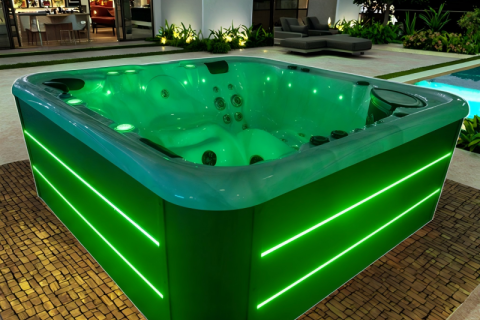
- Home
- >
News
Generally speaking, for a large, standard-sized outdoor spa jacuzzi tub (approximately 2.2 meters square), six to eight people are recommended for ground handling. For high-altitude installation or in complex terrain, this number should be increased to eight or more people, using a combination of lifting equipment and a sliding rail system.
If your outdoor spa jacuzzi bathtub is used frequently, water quality changes may be noticeable, requiring frequent monitoring. In this case, a water quality monitor can greatly simplify water quality management, monitoring water quality changes in real time to ensure optimal water quality.
If your area has hard water, particularly high concentrations of calcium and magnesium ions, installing a water softener will help improve the lifespan of your spa jacuzzi tub and enhance the spa experience. If the water source in your area is soft or pure, installing a water softener may not be necessary.
The tub's plumbing system is a complex network through which water circulates. If the plumbing isn't cleaned promptly or the filtration system malfunctions during use, water can accumulate in the tub, breeding grounds for bacteria and mold.
Chlorine is one of the most common spa jacuzzi tub disinfectants. It effectively kills bacteria, disinfects, and inhibits algae growth. Common forms of chlorine include calcium chloride (Ca(ClO)2) and trichloroisocyanuric acid (TCCA). The recommended dosage is 1-3 ppm per gallon of water. Generally, add as needed to maintain this range.
Choose a fixed time daily or weekly (such as 30–60 minutes before bed or on weekend evenings) to create a sense of anticipation and promote long-term benefits. Select the jet pattern according to your needs (direct jet for deep pressure, rotary jet for kneading, multi-hole jet for relaxation), and use zoned controls to alternately target relaxation for the shoulders, back, waist, and legs.
Outdoor spa jacuzzi: Connecting the power cord yourself is not recommended Connecting the power cord to an outdoor spa jacuzzi is a complex process involving electrical safety and requires compliance with relevant regulations and necessary safety measures. Due to the high technical requirements and safety risks involved in electrical installation, it is recommended that users hire a professional electrician to perform the installation.
Water can be categorized as either soft or hard, depending on the degree of hardness. ·Hard water: Water has high concentrations of calcium and magnesium ions, typically exceeding 120 mg/L. ·Soft water: Water has low concentrations of calcium and magnesium ions, typically below 60 mg/L.
The main water flow modes can be categorized as follows: 1. Jet Stream Mode 2. Pulsating Massage Mode 3. Rotary Whirlpool Mode 4. Air Bubble Mode 5. Cascading Waterfall Mode 6. Cross-Flow Mode 7. Targeted Deep Tissue Mode
If the cable plug is loose, the power outlet is damaged, or the power line is disconnected, the electrical system will not work properly, causing the spa bathtub to fail to start or stop in the middle of work. Power problems are often easy to overlook, so checking whether the power cord and the outlet are firmly connected and whether there is any damage is the first step to check.
The water circulation system of an outdoor spa jacuzzi includes several key components, mainly including water pumps, filtration systems, heating systems, pipes and nozzles. These parts each have different functions, and through close cooperation, they ensure the circulation, heating, cleaning and massage of water flow.
When children use outdoor spa jacuzzi, they must be accompanied by adults and supervised at all times. Even if the water level of the spa bathtub is low, children's activities in the water may cause accidents, so parents must always pay attention to their children's movements.












